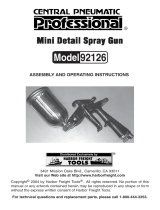
For technical questions, please call 1-800-444-3353;
Troubleshooting section at end of manual.
Page 4 SKU 93205
7. Use eye and ear protection. Always wear ANSI approved impact safety goggles.
Always wear an ANSI approved dust mask or respirator when using this Spray
Gun.
8. Do not overreach. Keep proper footing and balance at all times. Do not reach over or
across running machines or air hoses.
9. Maintain tools with care. Keep tools clean for better and safer performance. Follow
instructions for lubricating and changing accessories. Inspect tool cords and air hoses
periodically and, if damaged, have them repaired by an authorized technician. The
handle must be kept clean, dry, and free from oil and grease at all times.
10. Disconnect air supply. Disconnect air hose when not in use, when changing
accessories, and during maintenance.
11. Remove adjusting wrenches. Check that adjusting wrenches are removed from the
tool before attaching to the air source.
12. Avoid unintentional starting. Be sure the trigger is in the Off position when not in use
and before attaching to the air source. Do not carry any tool with your finger on the
trigger, whether it is attached to the air compressor or not.
13. Stay alert. Watch what you are doing, use common sense. Do not operate any tool
when you are tired.
14. Check for damaged parts. Before using any tool, any part that appears damaged
should be carefully checked to determine that it will operate properly and perform its
intended function. Check for alignment and binding of moving parts; any broken parts
or mounting fixtures; and any other condition that may affect proper operation. Any part
that is damaged should be properly repaired or replaced by a qualified technician. Do
not use the tool if the trigger does not operate properly.
15. Replacement parts and accessories. When servicing, use only identical replacement
parts. Use of any other parts will void the warranty. Only use accessories intended for
use with this tool. Approved accessories are available from Harbor Freight Tools.
16. Do not operate tool if under the influence of alcohol or drugs. Read warning labels
if taking prescription medicine to determine if your judgement or reflexes are impaired
while taking drugs. If there is any doubt, do not operate the tool.
17. Use proper size and type extension cord. If an extension cord is required for the
compressor, it must be of the proper size and type to supply the correct current to the
compressor without heating up. Otherwise, the extension cord could melt and catch
fire, or cause electrical damage to the compressor. Check your compressor’s manual
for the appropriate size cord.
18. Maintenance. For your safety, maintenance should be performed regularly by a qualified
technician and the unit must be thoroughly cleaned out after every use.
Improper
cleaning of the Spray Gun is a common reason for the Spray Gun to jam or not
perform properly.
















